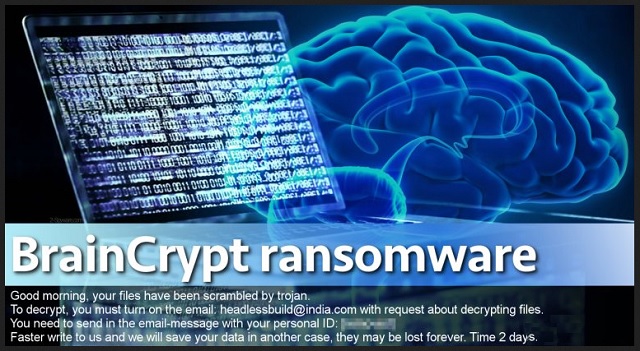I wrote this article to help you remove Braincrypt Ransomware. This Braincrypt Ransomware removal guide works for all Windows versions.
Braincrypt belongs to the dreaded family of ransomware and as such member, it will cause you a ton of issues. According to researchers, ransomware pieces are the most dangerous cyber infections out there and there is a reason for that. They follow a pretty standard pattern: Invade, Encrypt, Extort. First, they sneak into your machine without you realizing. Then, they encrypt everything you have stored on board. And finally, they extort you for money. Braincrypt does exactly the same. It was developed with the Go programming language and it will cause you nothing but a headache.
What Braincrypt does first after entering your PC is performing a scan. It scans your machine in search for valuable data to encrypt and it does find everything. Pictures, music, videos, files, Word documents, presentations, etc. They all get encrypted with a strong encryption algorithm and thus become inaccessible to you.
The ransomware effectively denies you access to all of your important information. It also appends its pesky “.braincrypt” extension at the end of each locked file. For example, a picture named “smile.pjg” after encryption becomes “smile.pjg.braincrypt”. Seeing this appendix means that you are no longer able to open any of your files. The ransomware keeps them hostage for a reason, though. Once the file-locking process is over, Braincrypt drops a TXT file on your desktop as well as in every folder, containing encrypted data. This file is the ransom note from the crooks behind the ransomware and it is called !!! HOW TO DECRYPT FILES !!!.txt.

Isn`t it strange that the exact people responsible for the loss of your data are now giving you instruction on how to get it all back? Yes, it is. Let`s explain. According to the note, the only way of recovering your files is by obtaining a special tool and you have contact the crooks via one of the following email addresses to receive further information – braincrypt@india.com and headlessbuild@india.com. Of course, this tool doesn’t come for free.
The hackers promise to send it to you as soon as you pay a hefty ransom. Of course, it is all about money. Money is all ransomware pieces` main goal. Usually, the ransom varies between 0.5 and 1.5 Bitcoins which is not what we call a small sum. A single Bitcoin equals around $600. So, you pay, you get the key. But is that as simple as it seems? No! No, it is not because you can never trust a cybercriminal. How do you know that they will keep their end of the deal? Or, how do you know that they will send you a fully-working decryptor? You can never be sure.
In fact, most of the times when the victims pay, the cybercriminals don’t deliver. And even if they do send you what you paid for and you decrypt your files, you are still double-crossed. The said decryptor only goes so far as unlocking your data. It doesn’t remove the infection itself. Braincrypt remains on your machine ready to send you back to square one anytime.
One thing is sure: you cannot win by paying the ransom. What you are doing, on the other hand, is sponsoring crooks with your money and helping them expand. Not to mention that you are also giving them access to your personal and financial data and nothing good can come out of this. You are only making your already bad situation even worse. That’s why ignore the hackers` messages and don’t give them even a single dollar. Instead, use our removal guide below and remove the infection from your PC once and for all.
Once your computer is infection-free again, make sure it will stay that way. Do you know how ransomware travel the Web? They use the old but gold means of infiltration. One of the most effective tactics are still the spam emails. Very often the hackers attach a ransomware to an email, which they send directly into your regular inbox. If you open it, you get infected. Email from unknown sender must be deleted immediately as in most cases they deliver malware.
You have to be more careful and not only with suspicious messages. The web is filled with parasites, waiting to infect you. Stay away from shady pages and illegitimate sources. Don’t click on any ad that comes your way. And, be extra careful when you are installing a program. Remember that a little bit more attention pays off.
Braincrypt Ransomware Removal
Method 1: Restore your encrypted files using ShadowExplorer
Usually, Braincrypt Ransomware deletes all shadow copies, stored in your computer. Luckily, the ransomware is not always able to delete the shadow copies. So your first try should be restoring the original files from shadow copies.
- Download ShadowExplorer from this link: http://www.shadowexplorer.com/downloads.html.
- Install ShadowExplorer
- Open ShadowExplorer and select C: drive on the left panel

- Choose at least a month ago date from the date field
- Navigate to the folder with encrypted files
- Right-click on the encrypted file
- Select “Export” and choose a destination for the original file
Method 2: Restore your encrypted files by using System Restore
- Go to Start –> All programs –> Accessories –> System tools –> System restore
- Click “Next“

- Choose a restore point, at least a month ago
- Click “Next“
- Choose Disk C: (should be selected by default)
- Click “Next“. Wait for a few minutes and the restore should be done.
Method 3: Restore your files using File Recovery Software
If none of the above method works, you should try to recover encrypted files by using File Recovery Software. Since Braincrypt Ransomware first makes a copy of the original file, then encrypts it and deletes the original one, you can successfully restore the original, using a File Recovery Software. Here are a few free File Recovery Software programs:

